Key takeaways:
- Selective mutism is an anxiety disorder where children can speak in familiar settings but struggle in social situations due to overwhelming anxiety.
- A positive mindset and gradual exposure to speaking in safe environments are essential for overcoming the challenges of selective mutism.
- Mindfulness techniques and setting realistic personal goals can significantly enhance coping strategies and build confidence.
- Sharing experiences with others and creating a supportive environment foster connection and empathy, essential for personal growth.
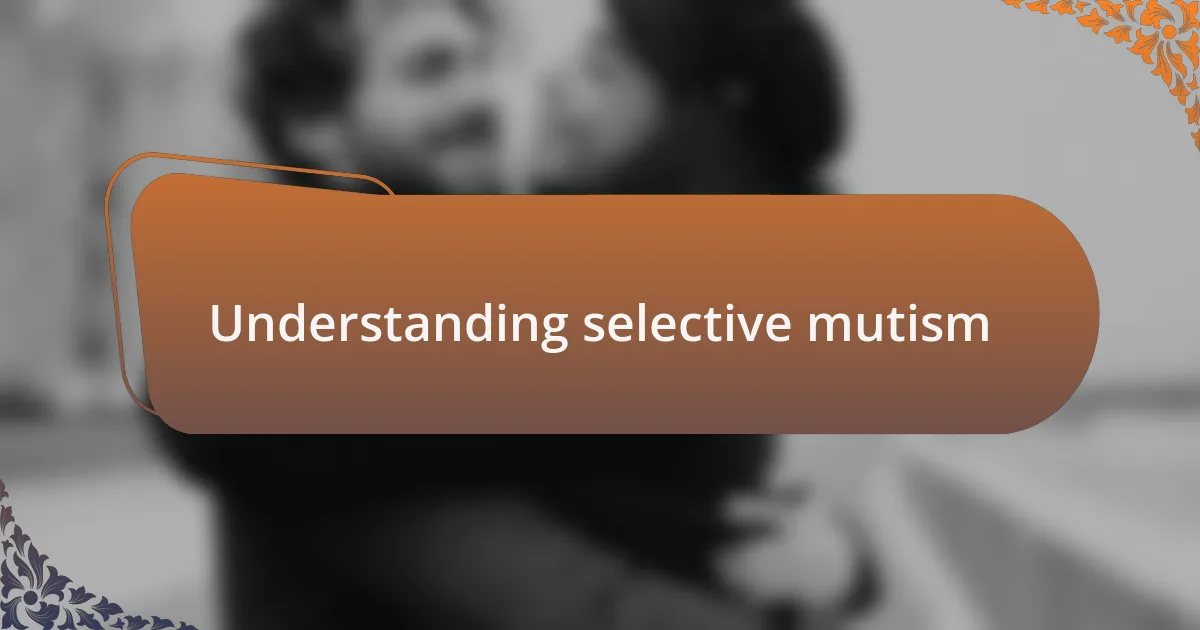
Understanding selective mutism
Selective mutism is a complex anxiety disorder primarily affecting children, characterized by an inability to speak in certain social situations despite having the ability to talk in other settings, like at home. I remember one young girl I met who was vibrant and chatty around her family but would freeze up in the classroom, leaving her teacher and peers puzzled. It makes you wonder: how can someone who has so much to say feel so trapped in silence?
For many, the silence stems from overwhelming anxiety rather than a desire to be mute. Each child’s experience varies, which can make understanding and addressing their needs challenging. When I think back to my own journey with anxiety, I recall those moments of feeling like my voice was locked away, and it felt deeply isolating. Have you ever felt that way, where you had thoughts swirling in your mind but couldn’t express them?
Navigating the waters of selective mutism requires patience, empathy, and often, professional support. I’ve seen firsthand how gradual exposure to speaking in safe environments can help, and the smallest victories—like a whispered answer during class—can bring immense joy and relief. It’s crucial to remember that progress may be slow, but every step toward communication is a triumph worth celebrating.
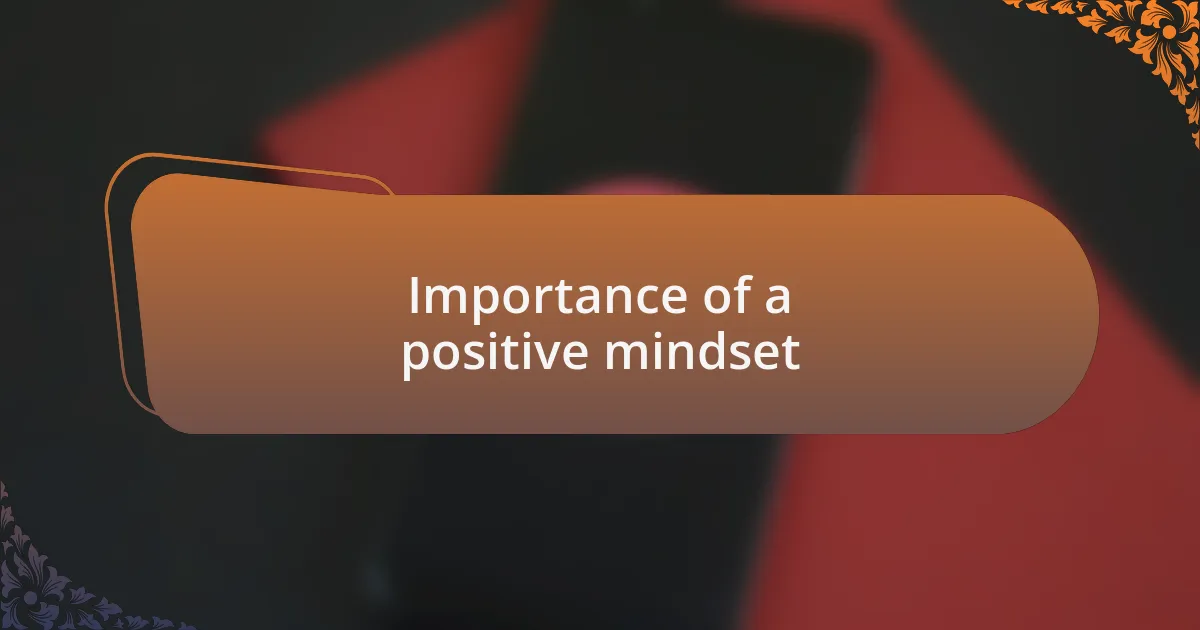
Importance of a positive mindset
A positive mindset plays a pivotal role in overcoming the barriers of selective mutism. I remember a time when I was struggling to speak in social situations. Shifting my perspective to focus on small achievements, rather than my fears, made a world of difference. Have you ever celebrated a small win that made you feel more confident?
When we foster a positive mindset, we create a supportive environment not just for ourselves, but for those around us. I vividly recall being surrounded by friends who encouraged me when I hesitated to speak up. Their positivity helped me realize that speaking—even just a few words—was nothing to fear. What if we viewed every attempt to communicate as a courageous victory?
Moreover, focusing on the positives can help reduce the anxiety that often accompanies selective mutism. Each time I reframed my thoughts, I felt the weight of my anxiety lift just a bit. It’s fascinating how a simple shift in thinking can lead to greater resilience and motivation. Isn’t it amazing how our minds can be powerful allies in our journey toward finding our voice?
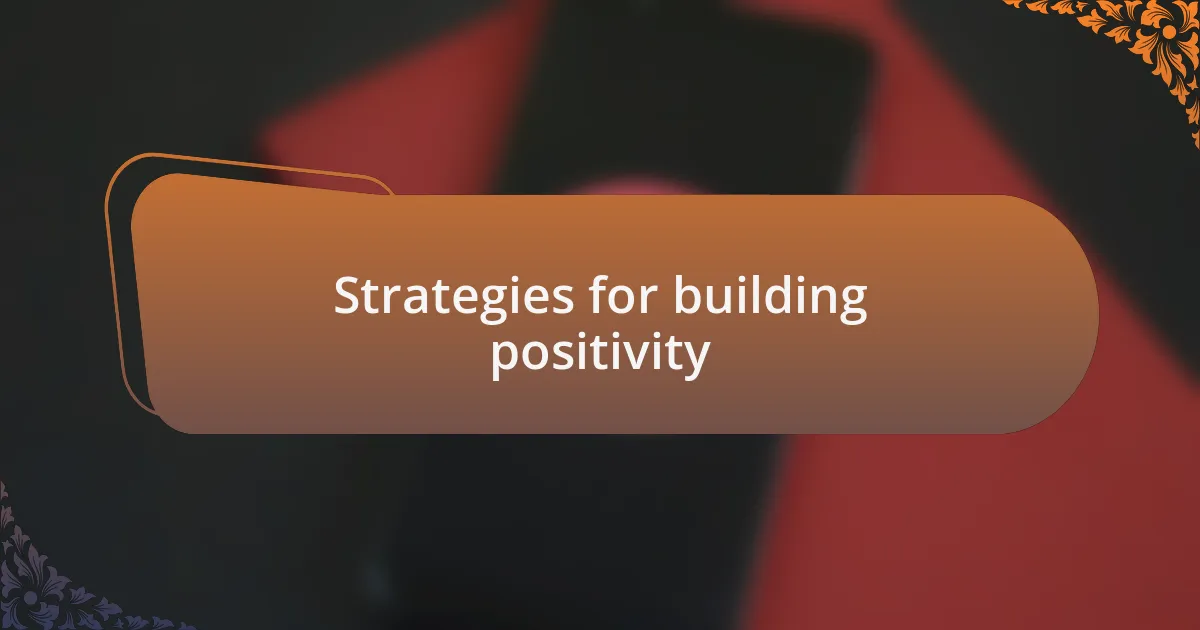
Strategies for building positivity
Finding ways to build positivity in our daily lives can truly transform our experience with selective mutism. For instance, I experimented with gratitude journals, jotting down even the simplest moments that sparked joy, like a warm cup of tea or a sunny day. Have you ever noticed how reflecting on these little details can shift your mood significantly?
Another effective strategy involves surrounding ourselves with uplifting influences. I once joined a support group where members shared their experiences and small victories. Hearing their stories reminded me that I wasn’t alone, which was incredibly empowering. How many times have you found motivation in someone else’s success story that resonated with your own challenges?
Additionally, embracing mindfulness has been transformational for me. Practicing deep breathing exercises, even just for a few minutes, helped ground me before daunting social interactions. Each breath served as a gentle reminder that I had the strength to navigate through my fears. What small mindful practices could you incorporate into your routine to help foster a sense of calm and positivity?
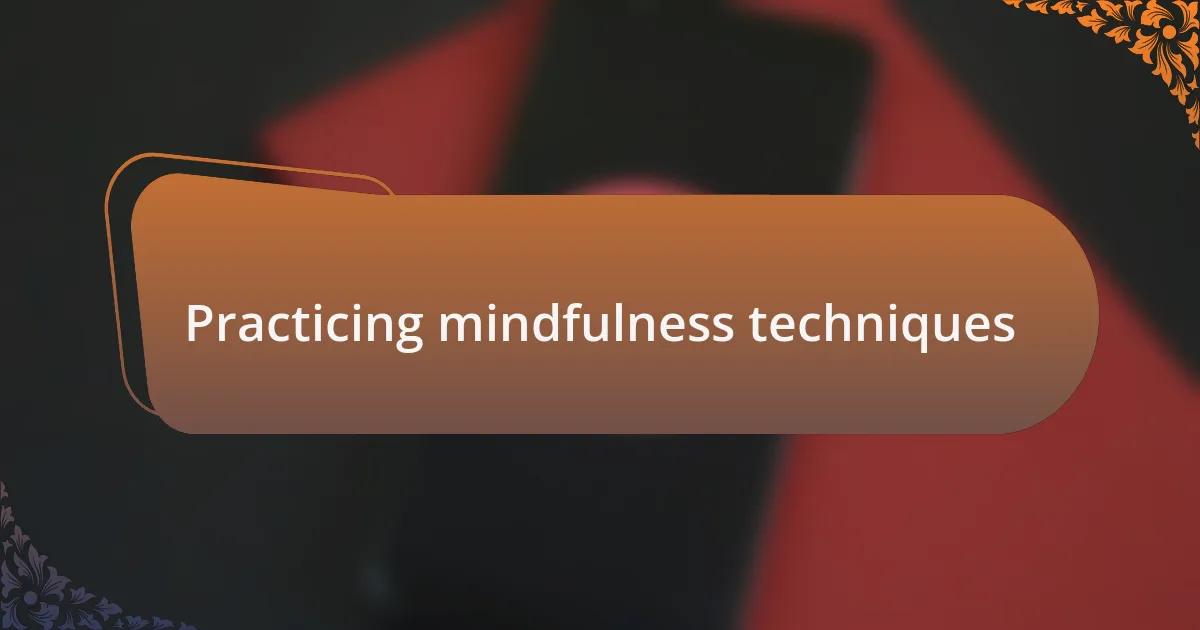
Practicing mindfulness techniques
Mindfulness techniques have been a refuge for me during challenging times. I once found solace in a simple five-minute meditation in the morning, where I focused solely on my breath. It sounds simple, but that practice brought clarity, allowing me to center myself before facing the day. Have you ever tried just sitting in quietude and observing your breath? It can be surprisingly grounding.
Another technique that resonates deeply with me is mindful walking. When I’m feeling overwhelmed, I often take a stroll in nature, paying attention to the sounds of rustling leaves and birds chirping. Each step becomes a deliberate action, pulling me away from swirling thoughts and planting me firmly in the present moment. Is there a particular place in your surroundings that makes you feel peaceful? Reflecting on that can enhance your mindfulness practice.
Incorporating mindful eating into my day was another pivotal change. I began to savor each bite of food, appreciating the textures and flavors rather than rushing through meals. This not only made my meals more enjoyable but also increased my gratitude for what I was nourishing my body with. Have you noticed how slowing down during meals can transform how you feel about the food you eat? It’s amazing how mindfulness can reshape everyday experiences.
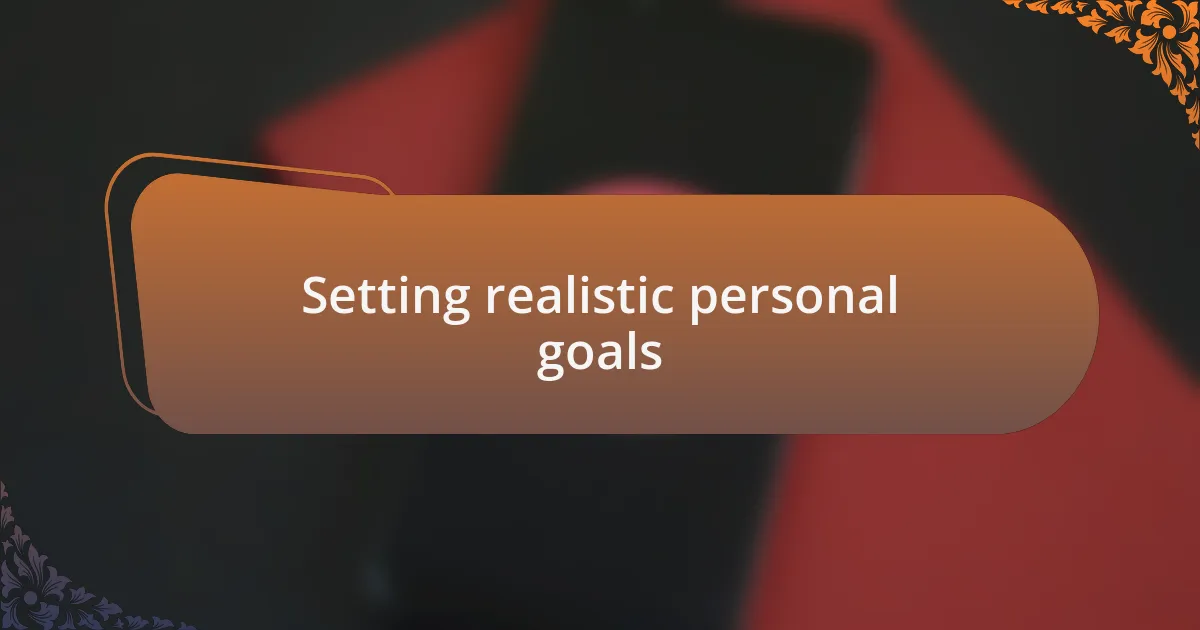
Setting realistic personal goals
Setting realistic personal goals has been essential in my journey toward a positive mindset. I remember the early days of my experience with selective mutism; I set a goal to say just one word in a conversation each week. It felt achievable and, with each small success, my confidence grew. Have you ever noticed how little victories can lead to significant changes over time?
As I progressed, I learned to break down my larger aspirations into bite-sized objectives. For instance, rather than striving to speak fluently in public right away, I focused on participating in small group discussions first. This gradual approach not only felt less daunting but also built a supportive framework for my growth. When was the last time you took a moment to celebrate a small achievement? Those moments are vital in reinforcing our resilience.
Setting deadlines for my goals has played a crucial role as well. Initially, I struggled with vague aspirations like “I want to improve my communication.” By pinpointing specific, realistic timelines—like expressing my thoughts in a calm environment once a month—I created a tangible path forward. Do you find that having concrete timelines encourages you to stay focused? It certainly has helped me maintain momentum.

Sharing experiences with others
Sharing experiences with others has been a transformative part of my journey. I vividly recall the first time I opened up about my struggles with selective mutism in a support group. The warmth and understanding I received from others who had similar experiences made me feel less isolated. Have you ever felt that relief when someone truly gets what you’re going through?
Connecting with others has also offered me new perspectives and coping strategies. For instance, a fellow participant shared a technique she used to combat anxiety before speaking—it was a game changer for me. When I applied her approach during a challenging moment, I felt empowered, reminding me of the power of community in our journey.
In many ways, shared experiences are a bridge to healing. I often find that the stories we tell not only resonate with others but also help us make sense of our own feelings. Reflecting on these interactions, I realize that each conversation strengthens not just my positive mindset but also my appreciation for the collective strength we share. How has sharing your story changed your outlook?
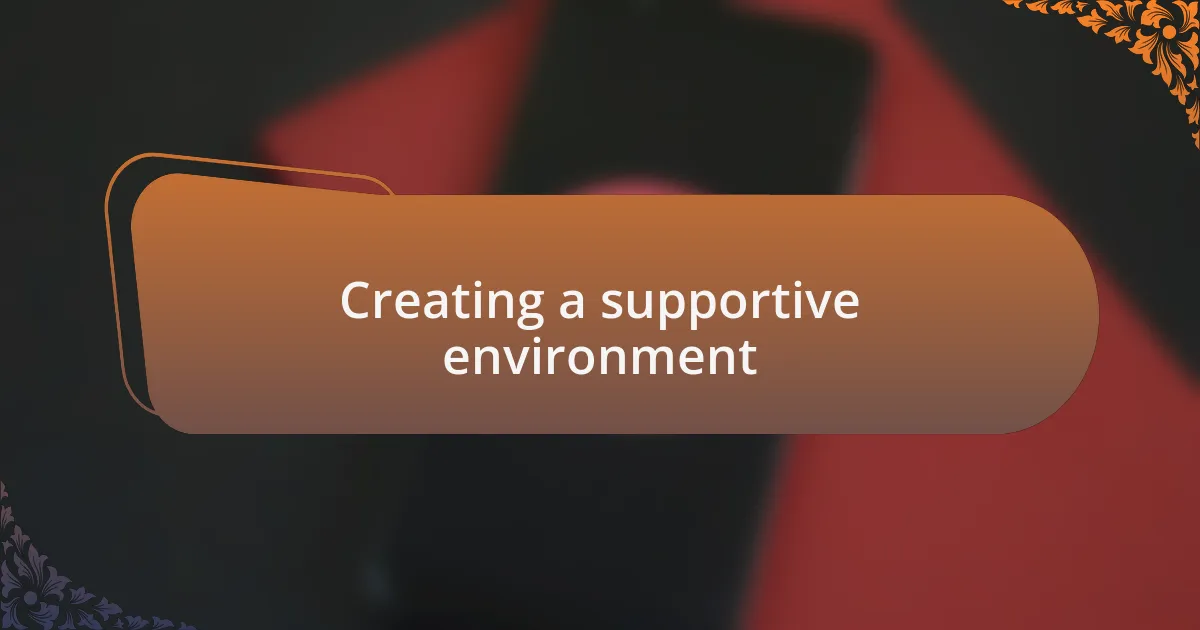
Creating a supportive environment
Creating a truly supportive environment can significantly shape our experiences with selective mutism. I remember rearranging my workspace to be more welcoming, adding calming colors and personal touches that made me feel secure. Have you considered how the space around you influences your ability to communicate?
I often encouraged family and friends to be patient with me, clearly expressing what I needed to feel at ease. For example, I found it easier to start conversations when I was in familiar settings, such as my living room rather than a bustling café. This simple change made a world of difference—I could sense the tension easing, allowing me to focus on expressing myself without the fear of judgment.
In nurturing a supportive atmosphere, I also learned the importance of celebrating small victories. When someone celebrated my decision to speak, even in a whisper, it felt monumental. Don’t underestimate how powerful these moments are; each one contributes to building confidence and reinforcing a positive mindset. How can you acknowledge and celebrate your milestones along the way?